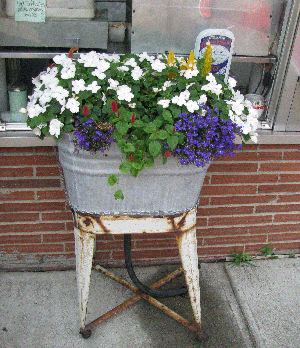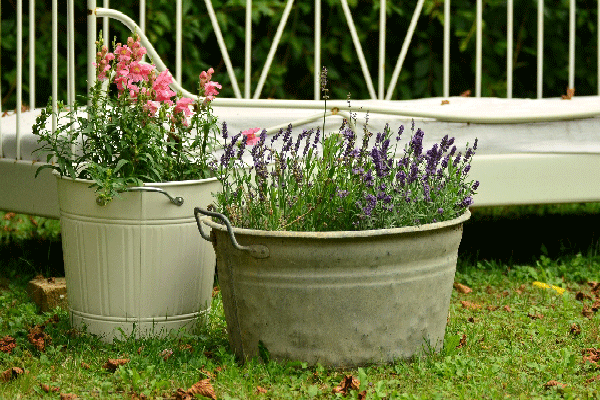Now is a good time to plan and prepare for container gardens on your patio, deck, or balcony. If you wait until the spring flower bug bites in late April or May, you'll buy whatever container is readily available, which usually is neither the least expensive nor the most interesting. The criteria for selecting a container will vary with the style of your house and your personal taste, but it has been my experience that recycled or handmade containers are often the most satisfactory.
There are three basic questions when selecting a container, but after those questions are answered, your only limit is your imagination.
 First, Be Sure the Plant Can Live. To ensure success, make sure your container provides these qualities.
First, Be Sure the Plant Can Live. To ensure success, make sure your container provides these qualities.
- Good drainage provided by plenty of holes in the bottom of the container and no drain dish to hold water around the plant roots.
- Sufficient root space for the plant to grow as large as you want it to. The same tree could be a bonsai in a 2‑inch pot, a patio decoration in a 10‑gallon container, or a shade tree in a 200‑gallon container.
- Enough weight to provide support to the plant. It is most distressing to find a prized plant sprawled across the deck days before all the flowers were to open. Many of today's containers are made of plastic, and when used with synthetic soil mixes, they are very light. If your plants will get top heavy, consider adding a few stones or a brick to the bottom of the container before planting.
Second, Be Sure You Like Its Appearance I know many people feel comfortable buying a container that the staff at the garden center says will look great. But quite frankly, how do they know? They've never been to your house. Moreover, why in the world should their tastes make you feel comfortable and happy? Learn to trust your own creative impulses.
Third, Be Sure It Doesn't Cause Other Problems. Porous containers can leak moisture that can discolor or damage deck furniture. Balcony containers and second‑story window boxes can alienate the neighbors at watering time. If the containers are too heavy, there might be some structural damage to the building. Pots sitting directly on the surface of a patio may not drain properly or, at the least, may provide a haven for earwigs, pill bugs, or slugs. All of these issues can be corrected by careful selection and placement of containers.

